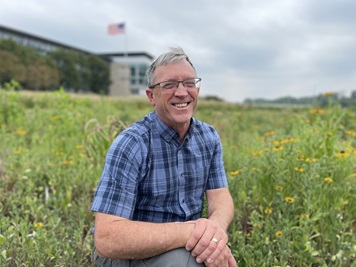
Turnpike's Pollinator Habitat in Full Bloom in Time for National Pollinator Week
Brilliant colors are exploding to life outside the Central Administration Building, putting on a show for travelers while providing a rest stop for bees and other critters.
This is the second summer of the PA Turnpike’s Pollinator Habitat Project, and with this being National Pollinator Week, it’s a good time to look back at how much the project has grown from a grassy lawn to a thriving habitat.
Stormwater Management Specialist Jim Kaiser is heading up the project, giving pollinators like bees and butterflies a small plot of land, filled to the brim with native Pennsylvania flowers and plants. Many species of pollinators – an important part of the eco-system – are dropping in population, and projects like this are meant to curb that decline and give them a place thrive, Kaiser said.
It seems to be working, attracting bees like the one in this photo, taken outside of the CAB.

And Turnpikers are enjoying it, too. "There was probably a little apprehension last year when we sprayed the areas out front, and they were wondering ‘why did we kill the grass?’” Kaiser said about the first step of the process last year. “Now, they can see the end results. It’s encouraging to hear people want to go outside and see the flowers and take pictures of them.”
The first pollinator habitats were planted at the CAB and Hickory Run last year. This year, Kaiser and his team have added a few more at the Harrisburg West, Bensalem and Irwin interchanges. Similar habitats will be incorporated into new sections of the Mon/Fayette Expressway, as well, he added.
The bloom changes through the season, too. This year, it started with a color show of reds and purples, now transitioning to yellows with more surprises to come. And Kaiser is pleased with how it’s all growing in.
It looks fuller this year,” he said. “Some varieties take a good year to come in. Next year will be even better. It takes a good three years for it to get established and come up.”
The pollinator habitats are not just a seasonal thing. After summer ends, crews cut the habitat down to stalks and stems about a foot high, serving as a habitat for small mammals and nesting insects through the colder months.
It’s a way to meet the Turnpike core value of sustainability.
“When we’re thinking about sustainability, pollinators are a big part of it, too me,” Kaiser said.
Learn more about National Pollinator Week and what you can do to help here.

